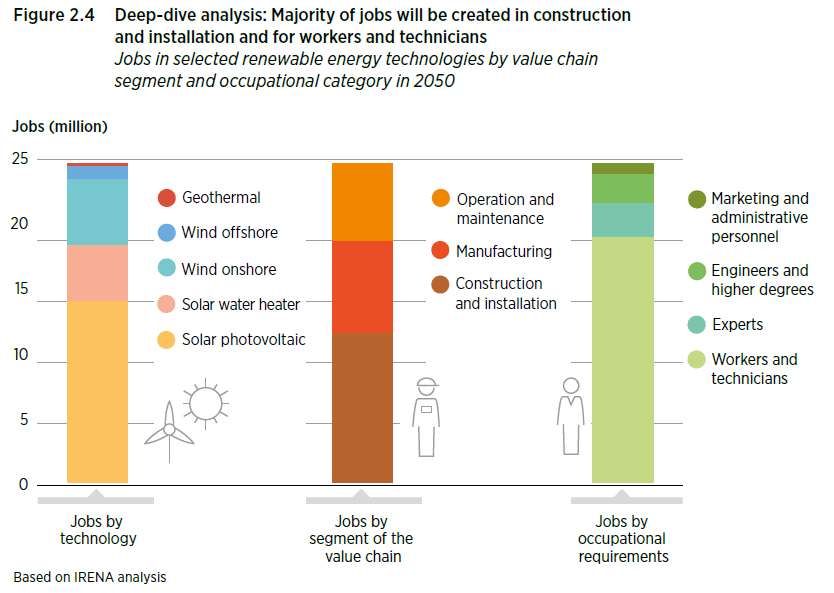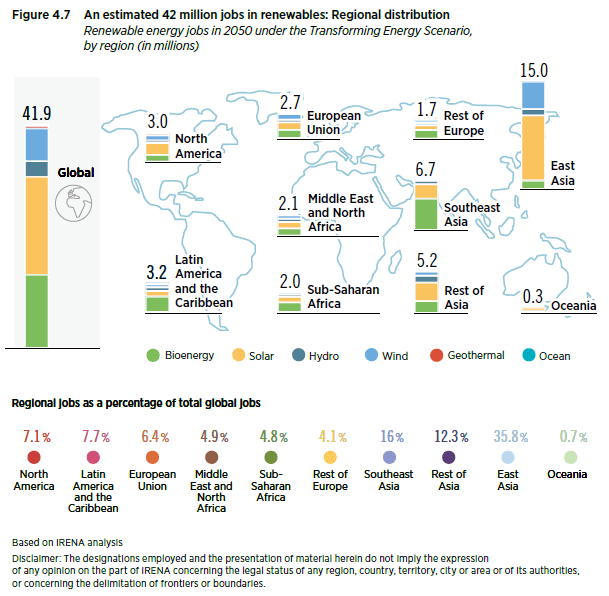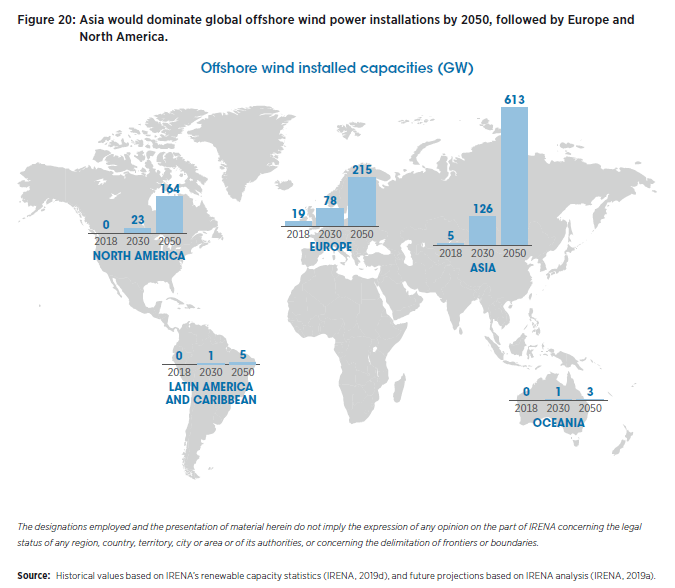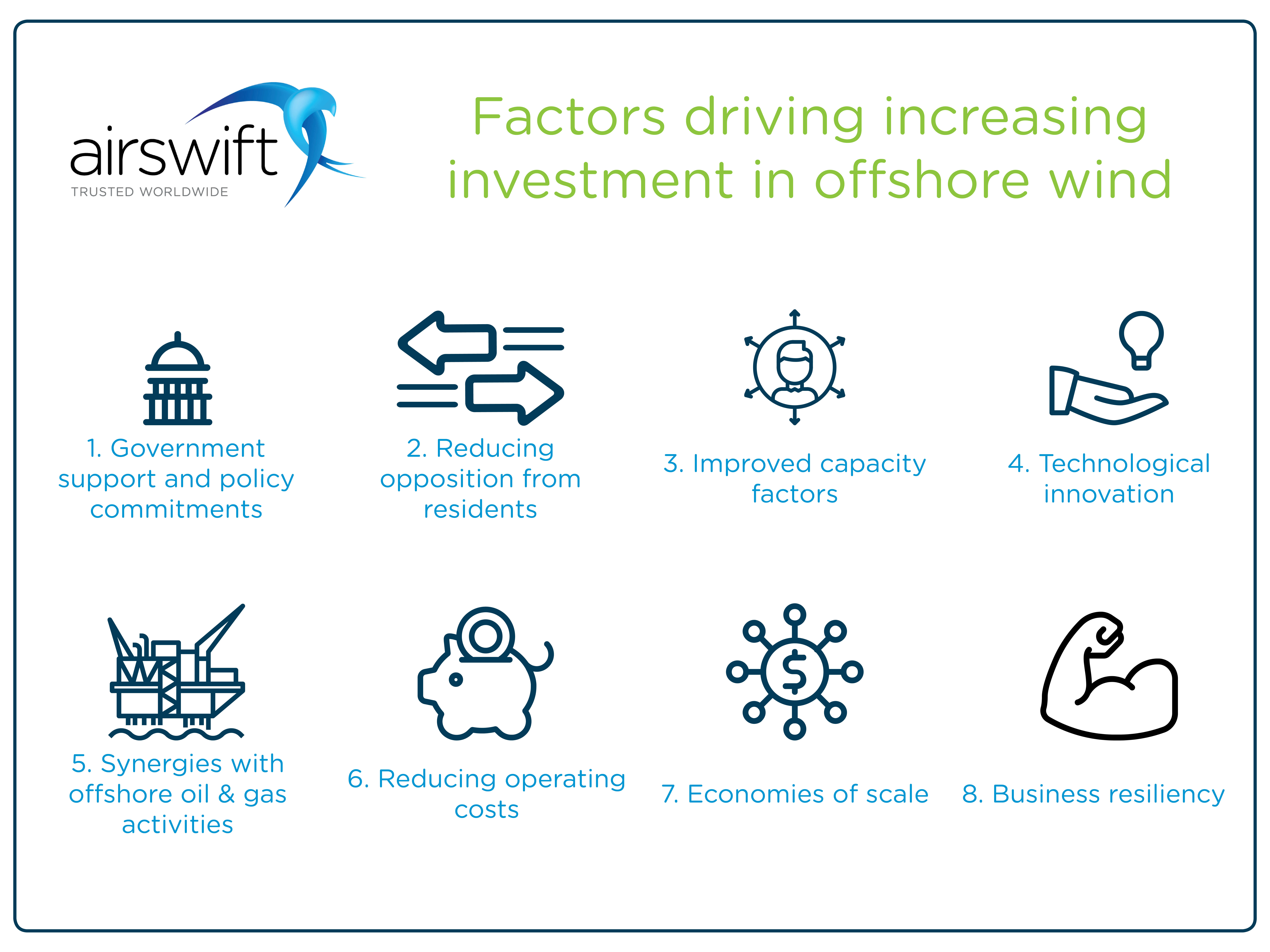
By
Rob Boyle
July 14, 2020
Updated
November 28, 2022
Source: fokke baarssen/Shutterstock
The tremors of COVID-19 have rippled throughout the energy sector…
Spending in upstream oil & gas has reduced by 32% YoY and investment cuts could be steeper than in 2015.
Goldman Sachs believes the sharp downturn will speed up the energy transition. In turn, this will create 15-20 million new jobs and $16 trillion of infrastructure investment by 2030.
While hydrocarbons have been lucrative, green energy is growing as a safe investment. Researchers have found that green firms achieve better annual returns and reduced volatility.
As investment in green projects increases, society and business will benefit. We will see economies of scale reduce costs, increase innovation and create jobs all over the world.
This blog helps energy professionals understand the changing economic situation and opportunities available within renewable energy, focusing specifically on offshore wind in Asia.
Below is an outline and links to the different sections:
- Job creation within renewable energy
- What is driving the increase in offshore wind projects?
- What project risks is the wind sector facing?
- Which offshore wind jobs are in demand?
- What is the size of the offshore wind market in Asia?
- Key offshore wind projects in Asia
Do you need to recruit STEM talent for an offshore wind project?
Job creation within renewable energy
In their latest Global Renewables Outlook, IRENA predicts the following:
- 42m jobs will be created across renewable energy by 2050
- The number of global wind jobs will rise by 600% to 6m between 2017-2050
- 60% of all employed energy professionals will be in Asia
There is also positive news for workplace diversity. IRENA estimate the current balance of gender participation to be 35% female in wind jobs.
By comparison, the conventional energy field is just 22% female. This will have a benefit to sector innovation, productivity and business performance.
Which renewable energy jobs are in demand?
A large proportion of these new roles will be in disciplines transferable from other energy sectors, including:
- Construction
- Energy Efficiency
- Engineering
- Grid and Infrastructure
- Operations and Maintenance
- Technical
Many roles will be new and need new skills and technology. There will also be scope for displaced workers to retrain. This could mitigate the impact of a relative decline in jobs within oil & gas.

Figure 1: Jobs in selected renewable energy technologies by value chain segment and occupation category in 2050 (International Renewable Energy Agency - Global Renewables Outlook)
Which regions will create the most renewable energy jobs in the future?
IRENA anticipate the majority of jobs to be created in Asia by 2050, with over half of all energy professionals located in the region. Solar and wind will be the most populated sectors. Bioenergy will be a driver of job creation in Southeast Asia and emerging markets like Latin America and Africa. Wind and hydro will be popular sectors in Europe.

Figure 2: An estimated 42m renewable energy jobs will be created globally by 2050 (International Renewable Energy Agency - Global Renewables Outlook)
What is driving the increase in offshore wind farm projects?
While most current wind installations are land based, offshore investment is increasing. Spending could even overtake offshore exploration and production by the end of the decade.
Currently, offshore wind is only 10% of offshore E&P but growing interest from Big Oil could change that.
The global offshore wind market grew nearly 30% per year between 2010 and 2018 and IRENA predict it will grow ten-fold from now until 2050. They estimate 45GW will be added each year by 2050, up significantly from the 4.5GW added in 2018.
Figure 3: Factors driving increased investment in offshore wind
The IEA predict that spending in offshore wind will increase by 13% a year and become a $1 trillion business by 2040.
This is driven by several key factors:
- Increasing government support and policy commitments to reducing emissions and ensuring energy security
- Reducing opposition from residents concerned about property values and the visual impact of wind farms
- A 15-fold increase in capacity factors over the past four decades. Newer offshore wind projects are approaching the efficiency of gas and coal plants. This is due to larger turbines and technology improving capacity factors to 40-50%.
- Power from the kinetic energy of air has seen great advances since the 1980's. Early turbines had a rated capacity of approximately 0.05 megawatts (MW). Modern turbines are capable of 10MW of offshore wind power.
- Synergies between offshore wind and offshore oil & gas activities. This will encourage shared knowledge, supply chains and market opportunities between the sectors.
- Reducing operating costs of wind powered electricity by 55% from 2018 to 2030.
- Economies of scale, synergies and digital innovation will bring the costs of operations and maintenance by a further 40% by 2040.
- In general, renewable energy is looking more resilient than the last recession. The New York Times highlight consolidations creating stronger businesses and balance sheets. The merger of Siemens Wind and Gamesa in 2017 is a good example of a whole being greater than the sum of its parts.
What risks are projects in the wind sector facing?
A key factor in the wind sector reaching its potential will be access to talent.
In particular, the recruitment, training and mobilization of expertise to emerging markets is crucial. We expect a large demand for experts from Europe, particularly the UK, Denmark, and Germany.
A lack of skilled professionals or restrictive immigration policies could delay projects. This would impact economic development, increase running costs and heighten energy security risks.
Over reliance on expatriate talent could also prevent successful delivery of projects. Operators must ensure that they also engage and train local communities. This will help maintain workforce levels, build domestic expertise, and develop political goodwill.
Which offshore wind jobs are in demand?
Increasing investment in offshore wind will create a buoyant job market for technicians and engineers. We are seeing a lot of demand for the following roles:
- Development Manager
- Project Management
- Wind Farm Construction Representatives – Offshore and Onshore
- Wind Jacket Installation Engineer
- Wind Technicians
- Wind Turbine Engineer
- Grid Connection Specialist
- Operations and Maintenance
- Client Representative – Electrical
- Client Representative – Civil Works
Airswift are working with several developers, contractors, and consultancies to hire for permanent employees and contractors with these skill sets.
What is the size of the offshore wind market in Asia?
Although 1,500GW of technical offshore wind potential is in Asia, only 0.4% is operational at present. A key limiting factor so far has been the relative lack of government support compared to Europe.
Could this be changing?
Asia Pacific was the destination for 50% of new wind project installations in 2019 and capital spend surpassed $10bn. Asia spent almost double the amount of Europe as it rapidly scales its wind capacity.

Figure 4: Offshore Wind Installed Capacities (GW) to 2050 (International Renewable Energy Agency - Future of Wind)
Below, we provide a brief outline of the top 10 Asian offshore wind projects in the pipeline.
Offshore wind in Asia - key projects
China
 China has more than 1,000 GW of technical potential for offshore wind, thanks to a coastline over 18,000km long. In 2018, China added 1.6 GW of offshore wind capacity, the most of any country.
China has more than 1,000 GW of technical potential for offshore wind, thanks to a coastline over 18,000km long. In 2018, China added 1.6 GW of offshore wind capacity, the most of any country.
Most projects are led by state-owned energy companies. Collaborations with CHN energy and SPIC saw European firms EDF and Equinor enter the market in 2019.
Offshore Wind Farm Jiangsu Zhugensha H1
A $600m project expanding on the first foreign-backed wind farm in China, delivered in December 2019. The first project, the 300 MW Dongtai IV wind farm, was a joint venture between EDF and China Energy Investment Corporation. Phase two, also known as Dongtai V, will add 200MW of power off the coast of Dongtai in Jiangsu province.
Indonesia
 Indonesia has prioritized renewable energy legislation as it aims to pivot from coal. Due to its volcanic geology, the country has great potential in geothermal energy. It also has an estimated total potential for onshore wind energy of 9.3 GW.
Indonesia has prioritized renewable energy legislation as it aims to pivot from coal. Due to its volcanic geology, the country has great potential in geothermal energy. It also has an estimated total potential for onshore wind energy of 9.3 GW.
The Indonesian government has targeted 1.8 GW of installed wind capacity by 2025.
Local projects such as the 75MW Sidrap Wind Farm will be essential to government targets. Indonesian fabrication yards will play a key role in global projects too. Yards in Batam and Karimun will support many projects with fabrication scopes for steel foundation jackets, electrical sub stations and suction piles.
Japan

Japan aims to install 4 GW of capacity by 2040, generating 7% of total electricity generated. The IEA estimates that Japan has the technical potential for 9x as much power generation. The main limiting factor is the number of shallow areas available.
Harnessing deep waters of over 60m could overcome this limitation. Innovations in floating turbines, such as in the 3.2MW Hibiki project, could be vital but costs are high. As floating turbines are an early technology, costs will reduce over the next decade. The Japan Wind Energy Association are expecting 18 GW of floating offshore wind turbines to be installed by 2050.
Japan has a long history of maritime, manufacturing, R&D and technological innovation. This has not yet been leveraged to executing large offshore wind projects. Project management, coordination and installation expertise may need to be recruited from abroad.
Government policy could be key to developing the Japanese wind sector. In particular, relaxing immigration policy and encouraging joint ventures with international firms.
Akita Noshiro Offshore Wind Farm Project
The Akita Offshore Wind Farm Corporation is developing a 54.6MW farm to be located near Akita Port. MHI Vestas has been selected as the manufacturer of the 13 turbines. A nearby project in Noshiro Port will use another 20 turbines produced by MHI Vestas. Commercial operations will begin in 2022 and will power 130,000 homes.
A larger development is also in the early planning stage to be located North of Akita Port. This project, led by Obayashi Corporation, has the potential to produce 455MW of power. Siemens Gamesa is the preferred turbine supplier and the project is due to start in 2024.
Offshore Wind Farm Kashima North and South
A development of two offshore wind farms in Kamisu City, Ibaraki Prefecture. Each project will produce 94MW of power. It is expected that the Kashima North project will be online sometime in 2020.
Once complete, the project will utilise 36 turbines, each with a capacity of 5.2MW. The operator, Wind Power Energy, estimates the project will power 110,000 households.
South Korea
 South Korea is the largest offshore wind market outside the EU, the United States and China. With shipbuilding and maritime expertise, South Korea is attractive for commercializing floating wind.
South Korea is the largest offshore wind market outside the EU, the United States and China. With shipbuilding and maritime expertise, South Korea is attractive for commercializing floating wind.
Many of these projects will be fabricated in the local yards of Ulsan and Geoje Island and build on their wealth of talent and expertise in fabrication.
The Green New Deal aims to create 133,000 jobs over the next two years by transitioning away from fossil fuels. The Renewable Energy 3020 Plan has set targets to produce 13 GW of offshore wind by 2030 and 25 GW of capacity by 2040. This would amount to 10% of Korea’s total electricity delivered by offshore wind by 2040.
Southwest Offshore Wind Farm Phase 1 to 3
This $8.4m offshore wind farm will be built 20 km off the southern city of Yeonggwang over three phases. When the final phase is complete in 2025, it will have an installed capacity of 2500 MW.
The first phase began in January 2019, with a project to install 20 Doosan Heavy Industries 3 MW turbines.
The final phase will be the largest and will add 2 GW of capacity. This will produce enough electricity to power approximately 1.4 million households. At $8.4m in value, the project is second only to Ke Ga Offshore Wind Park as the largest offshore wind project in Asia
Offshore Wind Farm Incheon
A 600MW wind farm project will be located off Deokjeok island, Incheon Province. An additional 100MW project will be added nearby in Yeongheung.
The estimated value of the project is around $2.6 million, and it will be fully operational in 2025.
Ulsan Offshore Wind Complex
The Green Investment Group (GIG) invested $1.5m to develop a 1.4GW complex off the city of Ulsan. The project will be completed over three phases, with the first 400MW of power coming online in 2022.
Project commissioning began with the installation of Korea’s first floating LiDAR. The LiDAR will collect essential data related to wind speed and direction over a two-year period. This data will be used to evaluate the impact on the local ecosystem, environment, and fishing industry.
Taiwan
 Taiwan is aiming to increase offshore wind capacity to 5.5 GW by 2025 and 10 GW by 2030. Bolstered by attractive wind conditions, Taiwan aims to generate 25% of energy from renewable sources by 2025.
Taiwan is aiming to increase offshore wind capacity to 5.5 GW by 2025 and 10 GW by 2030. Bolstered by attractive wind conditions, Taiwan aims to generate 25% of energy from renewable sources by 2025.
Greater Changhua Offshore Wind Farm
Led by the Danish innovator, Ørsted, phase one of this four phase project is due for completion in 2020. Construction of the onshore substations and transmission infrastructure is already underway. The establishment of the project structures will then begin at the end of 2021.
Located in Taiwan Strait off Changhua county, within the Da Changhua (Greater Changhua) Development Zone, the onshore construction project has created approximately 800 job opportunities already.
Changhua-1 and 2a wind farms are scheduled for commissioning in 2022, while the FID on Changhua 2b and 4 wind farms is expected in 2023. The four Greater Changhua wind projects are expected to comprise the biggest wind-power complex in Taiwan.
The final development will have a total capacity of 2,400 MW. This would be enough green power to supply 2.8 million Taiwanese households.
Vietnam
 Vietnam's National Power Development Plan VII has placed renewable energy at its center. This will be key to improving energy security and rural electrification levels. With coastlines of over 3,000 km and average wind speeds of 6-8mph, Vietnam has great wind potential.
Vietnam's National Power Development Plan VII has placed renewable energy at its center. This will be key to improving energy security and rural electrification levels. With coastlines of over 3,000 km and average wind speeds of 6-8mph, Vietnam has great wind potential.
The Global Wind Energy Council predicts that 4 GW of wind capacity will be added by 2028.
According to BP, the largest year on year increase in Asian wind production was in Vietnam, growing by 58.2%. This was supported by a 3,583% increase in solar production.
A key driver of this growth has been the generous offshore Feed-in Tariff (FiT) of 9.5c/KWh introduced in 2018. By comparison, neighbouring countries had reduced or removed FiTs for wind energy. Other drivers include tax exemptions to encourage investment.
The FiT has been designed to increase the number of projects and has a short cut-off of November 2021. The short timeline has encouraged the fast-tracking of projects to beat the deadline.
Offshore Wind Farm Phu Cuong (Phase 1)
This project is a joint development between Mainstream Renewable Power, Phu Cuong Group and GE Energy Financial Services. The cooperation will see the partners develop the 800MW wind farm with an expected cost of $2bn. The location will be within the intertidal zone along the Mekong River Delta region.
Phase 1 of the project will feature 150-200 MW of wind generation. A feasibility study estimates 1,000-2,000 jobs will be created during construction, with 55 permanent jobs added during its 20-year operational life. Start-up is expected to begin in 2022 and will be followed by phase 2, which will add 600 MW of offshore wind capacity.
Ke Ga Offshore Wind Park (also known as Thang Long Offshore Wind Project)
Operating in shallow waters of 45m, this 3.4GW project will operate in an area of around 2,000 square km. Located 20km offshore Ke Ga cape, off the south-central province of Binh Thuan, the total project investment will be at least $12bn and delivered in five phases.
The first 600MW phase will feature 64 turbines, each with an individual capacity of 9.5MW. Vestas Wind Systems and Mitsubishi Heavy Industries will be the turbine manufacturers. The main operator on the project is Enterprize Energy and construction is expected to begin in 2021
Nearshore Wind Farm Thanh Hai 1
Construction on this project will begin in 2021. The 32MW project will be located 2-5km off the coast of Ben Tre Province.
Phase 1 will be powered by seven SG 4.5-145 turbines provided by Siemens Gamesa. There is potential for a second phase to add a further 30MW of power delivered by the same technology.



